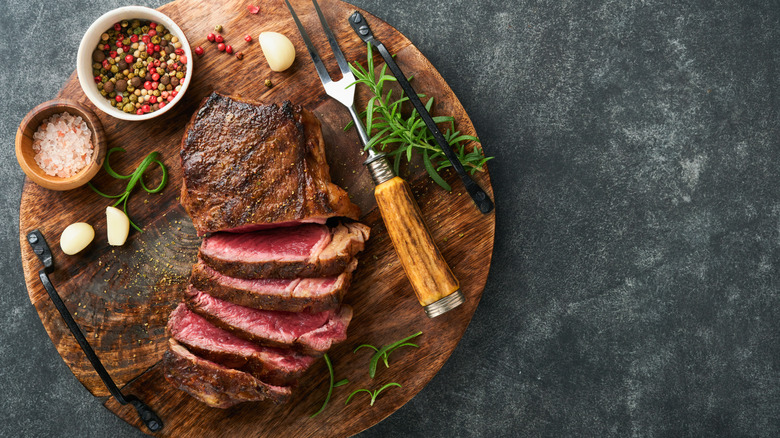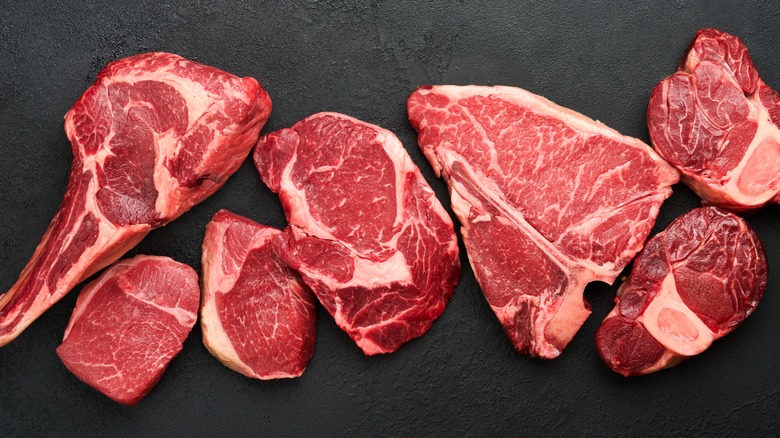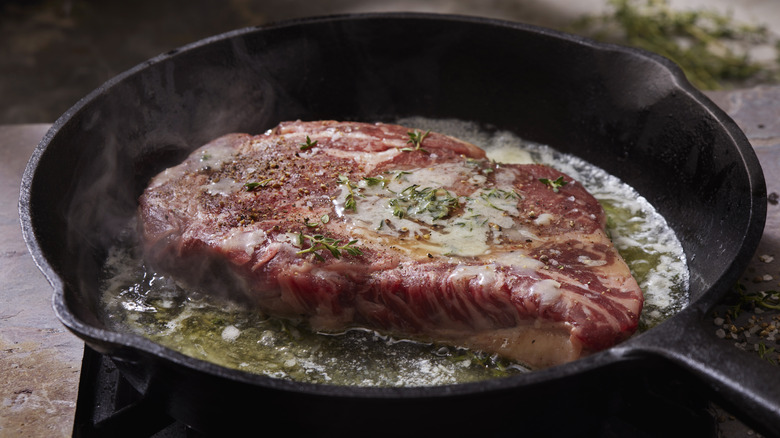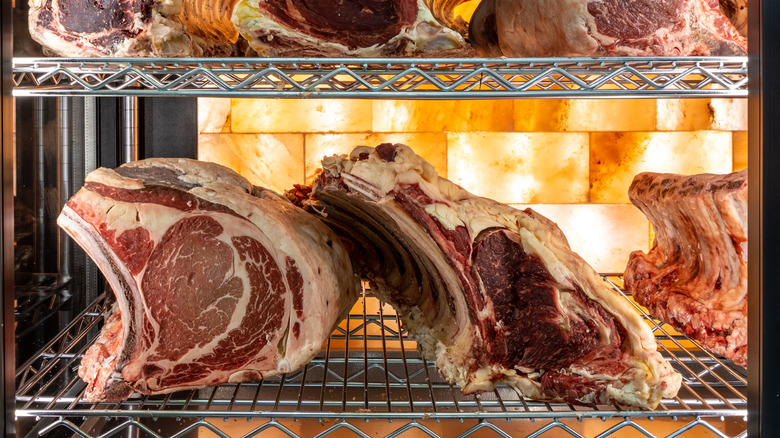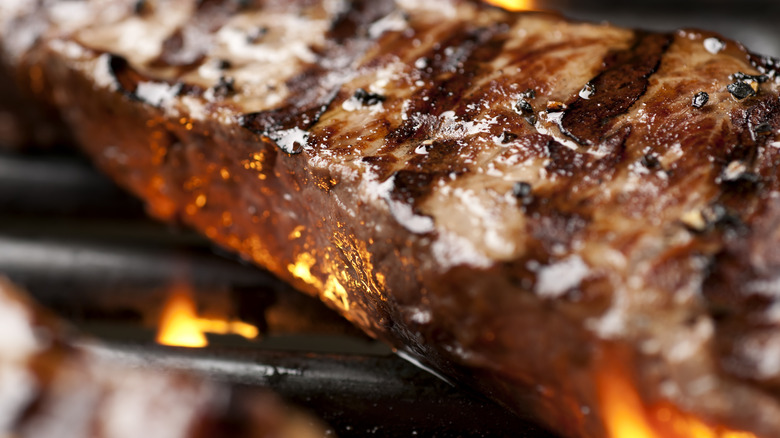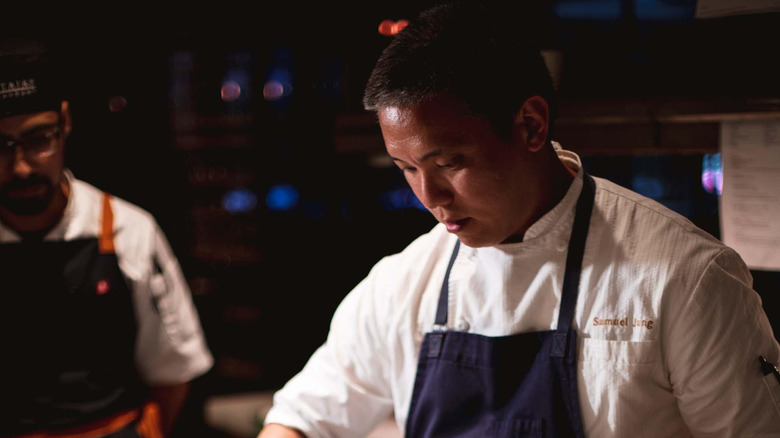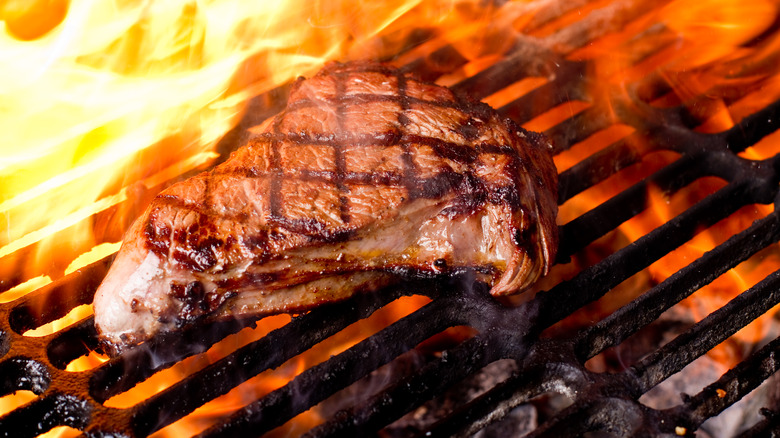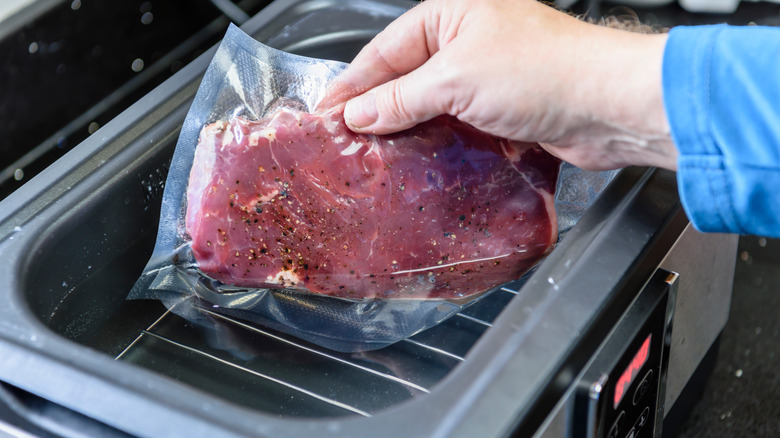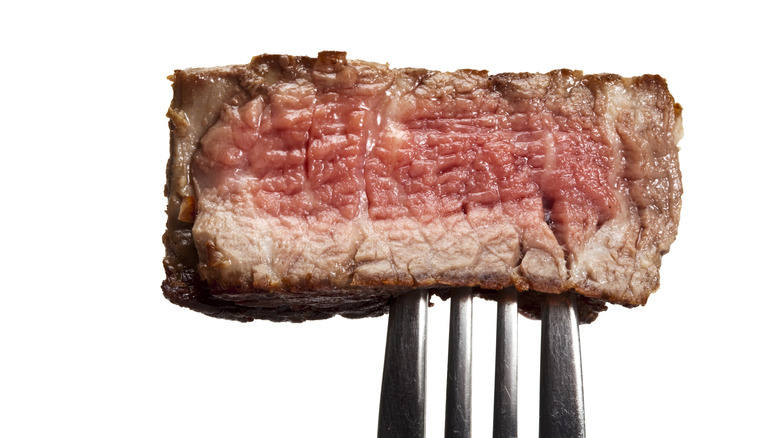Why Restaurant Steaks Always Taste Better Than The Ones You Cook At Home, According To Chefs
A luxurious steak is one food that's difficult to replicate at home and just seems to taste better at a restaurant. That's perhaps why steakhouses are so popular and have long become an important aspect of the American dining scene. Even though there are several different hacks to make a better steak in your own kitchen — like marinating the steak in Coca-Cola, for example — it's still not the same as ordering a good steak from a proper steakhouse. At the best steakhouses throughout the U.S., you'll get a thick cut of steak that's prepared to the right temperature, and with a nice sear that you can't quite get in a home-cooked meal. It also tends to be more flavorful both because of the meat quality and the seasoning.
However, better products and equipment are just a couple of the many reasons why going out to a restaurant for a delicious steak is worth the splurge. We've asked two executive chefs — Jonathan Milan of Ocean Prime in Beverly Hills and Samuel Jung of Los Angeles' Baltaire Restaurant — why they think restaurant steaks always taste better.
Restaurants have access to better meat products
Specialty grocery stores and higher-end butcher shops tend to offer better products than the average grocery store. And even though there are more of these popping up around the U.S., especially in metropolitan cities, restaurants still not only have better access the best cuts of steak, but also the best producers from around the country.
Chef Jonathan Milan says that most home cooks don't have similar access to small producers, explaining, "Specialty producers are often small operations and don't have the infrastructure and/or the means to distribute to large retailers." Having an ongoing relationship with a specialty vendor also means that the vendor will make sure the customer is allocated the best of its inventory. Milan tells us that not skimping on quality is perhaps the most important thing, adding, "It is difficult to make a good steak bad, but even harder to make a bad steak taste good."
Chefs use seasoning and butter more liberally
When people cook at home, they tend to be more conservative with the amount of butter they use for many reasons, including health and cost. However, you really can't make your steak taste at a professional level unless you use plenty of butter. According to chef Samuel Jung, one of the easiest things to replicate at home comes after you get a nice color and sear on both sides of the steak. "And then when you finish it," he tells us, "you want to add a good knob of butter in there. In a hot pan, you want the footer to brown, so you get that hazelnutty brown butter flavor."
The same thing holds true with salt and other seasonings. Home cooks tend to use less salt to cut down on sodium intake, but the resulting steak is naturally much less flavorful than what you'll get at steakhouses. "Be liberal with the seasoning," says Jonathan Milan, who encourages home cooks to also "keep in mind that a lot will fall off in the cooking process."
Steakhouses use aged steaks
Fresh isn't always best. In the case of steaks, an aged steak is a desirable option restaurants and steakhouses offer that customers can't easily find at their local grocery store or butcher shops. Aging improves beef in different ways, from tenderizing the meat to adding a distinct nutty flavor. "Steaks have to be aged (wet or dry) for a certain amount of time for the enzymes to break down the connective tissues after slaughter," chef Samuel Jung says. "A steak cooked and eaten right after slaughter will be tough and inedible."
There are two different types of aging: wet aging vs. dry aging. Dry aging takes longer (most dry-aged steaks are aged for 28-45 days) and builds a mold coating that is then cut and thrown away. Dry-aged steaks, then, are typically more expensive than regular or wet-aged steaks. Both processes tenderize the meat, but dry aging also gives the steak a more complex and intense flavor. Meanwhile, over just a few days, wet aging produces a milder flavor — but it retains more moisture, resulting in a juicier steak.
Chefs study techniques to achieve the Maillard reaction
The most important factor that impacts a steak's flavor is the same process that makes the meat change color as you cook it, which is called the Maillard reaction. This occurs between amino acids (proteins) and sugars when they are heated. This chemical reaction kicks off once the surface of the steak reaches a temperature higher than 285 F. The Maillard reaction is also responsible for that nice crust on a great grilled steak.
The high temperature isn't the only thing that's important in terms of achieving the Maillard reaction, though — and this is where a professional chef's techniques and knowledge come in handy. For example, for a proper Maillard reaction, you need the optimal moisture level, as Jonathan Milan tells us. A little moisture is required for the reaction to occur; however, too much moisture will ruin it, and it takes a lot of skill to deal with all the intricacies.
Professional cooks have much more experience
Practice makes perfect, and the same is true for cooking steak. For example, different cuts of steaks have different ways to best cook them, and it's hard for a home cook to experiment with all the cuts and practice enough to achieve the same skill. However, chefs gain that experience daily.
"I've cooked thousands of steaks," says Samuel Jung, "many different cuts." Not only that, but this knowledge and experience is passed on from one chef to the sous chefs and cooks — and this learned experience increases with each generation. "While it is easier now to cook a steak properly with fancy equipment ... it still doesn't beat all the time learning how to cook a steak from a chef," Jung explains. According to Jonathan Milan, there are several skills that chefs have come to know like the back of their hands. When it comes to preparing steak, these include how to temper the meat, when to rotate it, the effect of moisture, and more.
Better equipment allows for higher cooking temperatures
You may only need temperatures above 285 F to start the Maillard reaction, but for a nicely grilled steak, a higher temperature is better. Searing with super high heat gives the steak that perfect crust, while at the same time, it locks the juices and flavors inside, so the steak doesn't become dried out during the cooking process. The higher heat also helps sear the exterior of the steak quickly, before the inside becomes overcooked.
A home oven's broiler setting usually has a maximum temperature of 500-550 F. Meanwhile, professional-grade broilers can go well above 1000 F. For example, Baltaire uses French Montague broilers that have a radiant heat of 1600 F. At home, chef Samuel Jung recommends using a cast iron pan, saying, "... It's nice and heavy, it's thick, and it holds its heat." Though it still doesn't get quite as hot as a professional broiler.
Some restaurants use the sous vide method
Both chefs we spoke with agree that using the sous vide method is one of the best ways to improve your home-cooked steak. This is when the food is vacuum sealed and then cooked in a water bath that is kept at a precise temperature. As chef Jonathan Milan suggests, "Consider investing in a sous vide to simplify the process and get a consistent product every time."
If you want to try it out, we recommend first reading up on all you need to know about sous vide steak. While chef Samuel Jung doesn't need to use sous vide at Baltaire currently, he's used them for thicker cuts like porterhouse in the past, because these take longer to cook, and sous vide helps speed up the process. In this case, the steak would be cooked in a sous vide first and then seared on each side on a very hot grill. YouTuber Guga Foods also likes to sear his steaks with a torch after they're cooked in a sous vide.
Chef-approved tips for improving steak at home
A great steak from a restaurant is difficult to replicate for an average household and requires investments on kitchen tools and lots of practice. "It can be done at home with the right resources and equipment, but it'll be challenging," chef Samuel Jung says. "I've tried many times at home, and although delicious, it's not the same." But that doesn't mean that home cooks can't improve and make a great steak. Jung shares how he usually cooks a steak at home, telling us, "I just get a big heavy cast iron pan, it's quick to heat up ... and then just finish it with butter."
Chef Jonathan Milan shares a reminder about carryover or residual cooking, which is when the steak will continue cooking after it's taken off the heat because of the residual heat in the steak itself. "Take your steak off the heat slightly before you've reached your desired temperature, then rest your steak for at least a few minutes before slicing into it," he says. Otherwise, the residual cooking might lead to an overcooked steak. If all else fails, maybe just plan a dinner at a great steakhouse instead.
